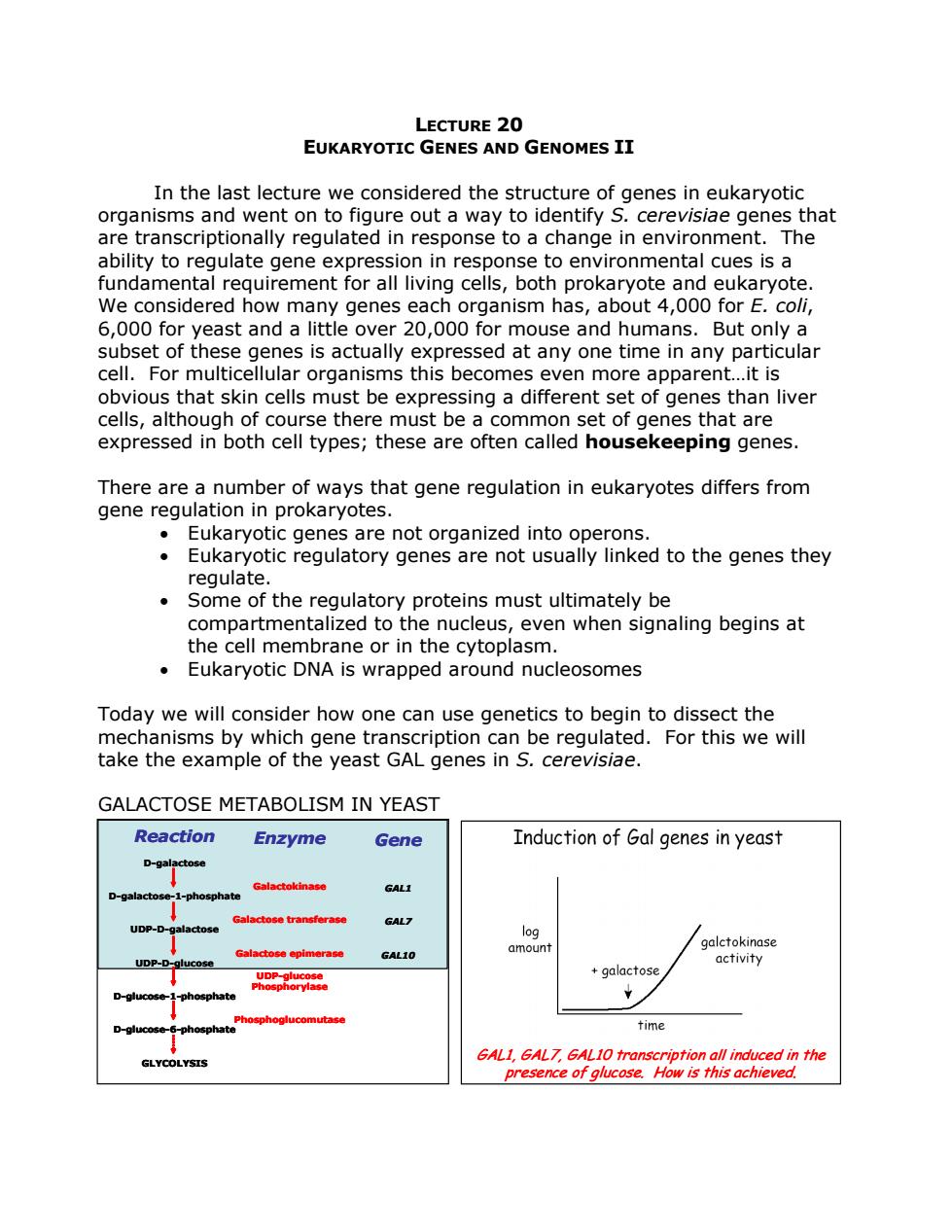正在加载图片...

LECTURE 20 EUKARYOTIC GENES AND GENOMES II In the last lecture we considered the structure of genes in eukaryotic organisms and went on to figure out a way to identify S.cerevisiae genes that are transcriptionally regulated in response to a change in environment.The ability to regulate gene expression in response to environmental cues is a fundamental requirement for all living cells,both prokaryote and eukaryote. We considered how many genes each organism has,about 4,000 for E.coli, 6,000 for yeast and a little over 20,000 for mouse and humans.But only a subset of these genes is actually expressed at any one time in any particular cell.For multicellular organisms this becomes even more apparent...it is obvious that skin cells must be expressing a different set of genes than liver cells,although of course there must be a common set of genes that are expressed in both cell types;these are often called housekeeping genes. There are a number of ways that gene regulation in eukaryotes differs from gene regulation in prokaryotes. Eukaryotic genes are not organized into operons. Eukaryotic regulatory genes are not usually linked to the genes they regulate. 。 Some of the regulatory proteins must ultimately be compartmentalized to the nucleus,even when signaling begins at the cell membrane or in the cytoplasm. Eukaryotic DNA is wrapped around nucleosomes Today we will consider how one can use genetics to begin to dissect the mechanisms by which gene transcription can be regulated.For this we will take the example of the yeast GAL genes in S.cerevisiae. GALACTOSE METABOLISM IN YEAST Reaction Enzyme Gene Induction of Gal genes in yeast D-galactose Galactokinase GAL1 D-galactose-1-phosphate Galactose transferase GAL7 UDP-D-galactose log galctokinase Galactose epimerase GAL10 amount UDP-D-glucose activity UDP-glucose galactose Phosphorylase D-glucose-1-phosphate D-glucc time GLYCOLYSIS GAL1,GAL7,GAL10 transcription all induced in the presence of glucose.How is this achieved.LECTURE 20 EUKARYOTIC GENES AND GENOMES II In the last lecture we considered the structure of genes in eukaryotic organisms and went on to figure out a way to identify S. cerevisiae genes that are transcriptionally regulated in response to a change in environment. The ability to regulate gene expression in response to environmental cues is a fundamental requirement for all living cells, both prokaryote and eukaryote. We considered how many genes each organism has, about 4,000 for E. coli, 6,000 for yeast and a little over 20,000 for mouse and humans. But only a subset of these genes is actually expressed at any one time in any particular cell. For multicellular organisms this becomes even more apparent…it is obvious that skin cells must be expressing a different set of genes than liver cells, although of course there must be a common set of genes that are expressed in both cell types; these are often called housekeeping genes. There are a number of ways that gene regulation in eukaryotes differs from gene regulation in prokaryotes. • Eukaryotic genes are not organized into operons. • Eukaryotic regulatory genes are not usually linked to the genes they regulate. • Some of the regulatory proteins must ultimately be compartmentalized to the nucleus, even when signaling begins at the cell membrane or in the cytoplasm. • Eukaryotic DNA is wrapped around nucleosomes Today we will consider how one can use genetics to begin to dissect the mechanisms by which gene transcription can be regulated. For this we will take the example of the yeast GAL genes in S. cerevisiae. GALACTOSE METABOLISM IN YEAST Reaction D-galactose D-galactose-1-phosphate UDP-D-galactose UDP-D-glucose D-glucose-1-phosphate D-glucose-6-phosphate GLYCOLYSIS Enzyme Gene GAL1 GAL7 GAL10 Reaction D-galactose D-galactose-1-phosphate UDP-D-galactose UDP-D-glucose D-glucose-1-phosphate D-glucose-6-phosphate GLYCOLYSIS Enzyme Gene GAL1 GAL7 GAL10 Reaction D-galactose D-galactose-1-phosphate UDP-D-galactose UDP-D-glucose D-glucose-1-phosphate D-glucose-6-phosphate GLYCOLYSIS Enzyme Gene GAL1 GAL7 GAL10 Galactokinase Galactose transferase Galactose epimerase UDP-glucose Phosphorylase Phosphoglucomutase Galactokinase Galactose transferase Galactose epimerase UDP-glucose Phosphorylase Phosphoglucomutase Galactokinase Galactose transferase Galactose epimerase UDP-glucose Phosphorylase Phosphoglucomutase GAL1 encoded GAL1, GAL7, GAL10 transcription all induced in the presence of glucose. How is this achieved. GAL1 encoded GAL1, GAL7, GAL10 transcription all induced in the presence of glucose. How is this achieved